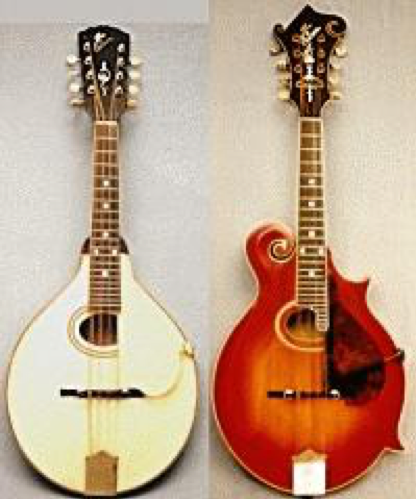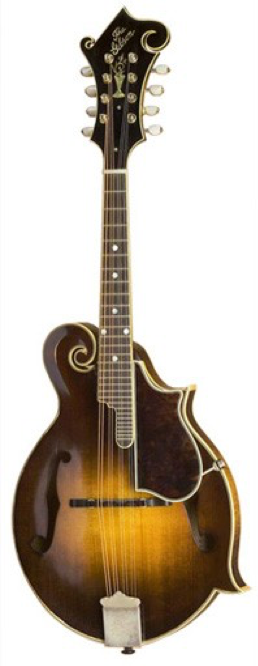Bluegrass Mandolin: Slinging the Back Beat
Ira Louvin was known to smash his mandolin to splinters in the middle of a performance, predating Jimi Hendrix and his ilk by at least a decade. And Bill Monroe famously defaced the Gibson logo on his very valuable Lloyd Loar mandolin’s headstock with a penknife[1]. Frank Wakefield was another Loar abuser. His offense: baking it in an oven after dousing it with spray paint and epoxy.
What is it about the mandolin that drives folks to do such deeds? Being a long-time mandolinist, I can certainly relate to both the frustration and the quest to pull better tone from this wonderful instrument. In this chapter, I will give you my perspective on the role of the mandolin in bluegrass music and hopefully save a few of you from unleashing the kind of violence reported in the opening paragraph.
A Brief Historical Overview
Mandolins are derived from lutes, so say the historians, and the mandolin’s origins are often associated with Italy. Polite people throughout that country performed on Neapolitan style ‘tater bug’ mandos with round backs and dulcet tones in years past. These instruments, which are almost impossible to hold and play unless you are propped up in the bow of a gondola, eventually made their way across the Atlantic Ocean to the new world. Below is a picture of a “tater bug.”

Orville Gibson, a Michigander in the early part of the 20th century, applied violin construction techniques to the mandolin and this yielded a much better sounding and easier to hold “archtop” design. Modern mandolins still come in the two original flavors that Orville had in the Gibson catalogue back then – a teardrop shaped “A” style (on the left in the picture below) which is pretty much unadorned and a “Florentine” or “F” model (on the right) that features a fancy scroll and points on the body of the mandolin.

Nobody in America had uses for such an instrument back then, so Gibson Company traveling sales people went from town to town, starting mandolin orchestras. This caper was evidently an effective way to sell 80 or 90 mandolin family instruments at a time, and as these salespeople made their way across the country, it surely resulted in a boost in the popularity of our beloved instrument.
Meanwhile, back in Kalamazoo, Mr. Gibson hired the acoustic engineer and mandolin virtuoso Lloyd Loar in 1919, who then went on to craft his eponymous mandolin by making radical changes to the existing archtop. Mr. Loar completely altered the mechanism of sound production – this would be the equivalent of adding independent suspension, unibody construction and radial tires to the archtop’s Model T-like design (see picture below).

Like Stradivarius violins, Mr. Loar’s designs have been studied and widely replicated by modern day luthiers and are actively sought after by bluegrass mandolinists everywhere. Lloyd quit Gibson in 1924 and his signature today is worth on the order of a quarter of a million dollars if it situated at the right place inside your mandolin. Serial # 73987 has such a signature, clearly visible thru the bottom F hole, which Bill Monroe found sitting in the Florida barbershop on that fateful day.
Big Mon
The mandolin was already popular with brother duets in the 1930s such as the Bolicks, the Delmores and the aforementioned Louvins but most especially the Monroes – Bill and Charlie. Back in the ‘30s, Bill Monroe’s incipient style that he played with brother Charlie was fairly typical of the times as exemplified in this recording of New River Train <link>. Contrast that with his post-1945 picking on Bluegrass Special, which is distinctly in the bluegrass style <link>. You can really hear the blues notes (attributed to influence from black bluesman Arnold Schultz) and the downstroking style with all that power. Listen to the clean triplets… he was at the top of his game back then[2].
Bill Monroe’s bluegrass style inspired lots of mandolinists to build on his impressive techniques. Modern bluegrass mandolin playing features lots of Bill-isms and has been extended to include innovations from other great artists. Let’s walk through five different memorable things about bluegrass mandolin and a few words about Bill and the other great mandolinists who pioneered these techniques.
The Mandolin as a Lead Instrument
The technique for picking out basic leads on the mandolin is not dissimilar to that of a flatpicking guitar, which we covered in the last chapter. The up/down/up/down rule for playing sixteenth notes must be followed (with few exceptions) and if you are in the process of learning this rule, I’d suggest having your local mandolin professional check your progress at least once to ensure you are doing it right. One of the things to listen for in mandolin breaks is the cleanness of the picking, which is harder to do than it might seem. Also listen for the lilt and syncopation of the notes and how they are placed on the rhythm supplied by the rest of the band (see the timing diagrams in the last chapter).
The best mandolin breaks in my opinion bear some resemblance to the melody. I have heard many a mandolin player make the mistake of showing off with lots of fancy licks and pyrotechnics before playing even a single phrase of the melody. To me, this clutter doesn’t sound very good in a mandolin break. Guitarists can get away with it but not mandolin players. Save your fireworks for the last phrase or two of the break or better yet, your second break if you’ve earned one. My favorite mandolinist in the “picking leads” department is Doyle Lawson. He just can’t be beat in tasteful phrasing of the melody, and his cleanliness and syncopation are to die for. Listen how Doyle kicks off the song Julie Ann – it makes you just want to get out of your chair and dance a jig <link>.
Crosspicking
We learned about this pattern of beating three against two in the last chapter (on the guitar). It is really handy to use on the mandolin for medium paced songs as it does a great job of filling in and automatically syncopating your notes. As I might have mentioned in the previous chapter, the mandolin virtuoso Jesse McReynolds invented this technique from thin air and he amply demonstrates it in his intro to the song I wish you knew < link >. I’d encourage all budding mandolin players to listen to Jesse and learn this advanced technique but only once you’ve fully mastered basic sixteenth note “up/down” picking.
Tremolo
Mandolin notes are characterized by a very quick decay and the only real way to sustain a long note in a slow song is to repeat it a zillion times in a very rapid fashion by vibrating your pick like an electric toothbrush. The trick to good tremolo is to keep your vibrations in time with the beat. This can be done with sixteenth note triplets, 32nd notes, or even 64th notes. Mandolinist David Grisman, AKA Dawg, has one of the finest tremolos on the planet. Here is a video of Dawg and Del waltzing with lots of buttery tremolo <link>. On the less cheery side of things, mournful sounding tremolo is especially good in helping your listeners really feel the pain during the ghoulish kill-your-girlfriend-and-then-go-to-prison-for-the-rest-of-your-life songs that are so much a part of bluegrass <link>.
Monroe Style Downstroking
This unique technique is a Bill Monroe original way of taking a mandolin break. The basic form of it is to take the “up/down” sixteenth notes and make them all downstrokes just like Bill used to do. It turns out by picking in this fashion, it will pretty much force you to play the proper timing and emphasis that the blues is known for. Try it and you will see what I mean. In addition, there are a few archetypal blues phrases that will need to be learned. Triplets and other trills are also part of this style and happen naturally by adding an upstroke or two back in to your all-downstroke series of notes. Listen again to Monroe’s Bluegrass Special, this time done by downstroke virtuoso Mike Compton <link>. Yep those are all downstrokes. Try doing them at that speed… The technique requires a good deal of practice but once mastered, you can use Monroe style downstroking for all kinds of useful purposes.
Holding the Backbeat with Chop Chords
Playing backup chords to accompany other instrumentalists and vocalists in the band may at first seem like a pedestrian task but it is actually one of the most important duties for our bluegrass mandolinist. The fully closed “chop” chord technique is used most of the time in driving rhythmic mandolin backup and is a vital part of the bluegrass sound. This “chop” chord is placed on each backbeat – exactly between the bass’ root and five notes (see the previous chapter on the bass). The combined effect is that of a drum set – the bass takes the role of the bass drum and the mandolin chop is the snare drum. Boom-chop. The technique was pioneered by our superhero Bill Monroe and one of his superpowers was a superpinkie that he would stretch to unimaginable places on the fretboard to play these bluegrass “chop” chords. You will need to do likewise if you want to play credible bluegrass mandolin. Once developed, your superpinkie will come in handy in picking out up-the-neck Monroe style leads. If you are interested, go get Mel Bay’s bluegrass mandolin book and practice those chord positions until every note can be sounded cleanly.
Returning to Ira Louvin, our destructive mandolinist, and why he
might have incurred such wrath towards such a beautiful instrument. Well,
a mandolin is a small instrument and is designed to have two sets of identical
strings in order to boost the loudness. As all mandolinists
must do, Ira was attempting to tune these identical strings to identical
pitches. If you’ve ever attempted this, you know that it is physically
impossible to do. As a result, the two strings are vibrating at
slightly different frequencies, and the consequence of this is an overtone
series with lots of coefficients, which fills the air with beat
frequencies. The resulting sound has a very complex tone and is
somewhat sweet… the sound that the mandolin is known for. But it
also drives mandolinists crazy and has resulted in the destruction of many a
good instrument in the hands of people like Mr. Louvin. I can relate.
[1] Seventeen years after Bill’s act of vandalism, the defaced veneer was removed. It was later sold in 2009 at Christies for $37,500 (link).
[2] Many people attribute the bluegrass sound to Earl and his Scruggs banjo style. Bill takes the opposite view and has been quoted as saying “If it hadn’t been for bluegrass, the five- string banjo would have never made it.”